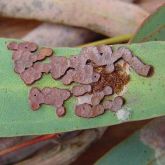Gall-forming insects

Typical Ophelimus wasp galls on Dunn's white gum (Eucalyptus dunnii) leaves

Severe leaf-galling symptoms on Dunn's white gum (E. dunnii)

Raised hard plate galls on western white gum (E. argophloia), with small round wasp emergence holes on galls

Severe plate galler damage on young western white gum (E. argophloia); note brown appearance of foliage

Thickened leaflets on new rose gum (E. grandis) shoots, caused by Blair's gall midge
Galls are misshapen growths found on plants, usually on the leaves or small branches. They are caused by a wide variety of agents including insects, mites, bacteria, fungi and nematodes.
On eucalypts, galls are often caused by tiny wasps and their larvae. Two wasp species of importance to plantation forestry are the dunnii gall wasp and the western white gum plate galler – both in the Ophelimus genus.
Another gall forming insect relevant to eucalypt plantations is a small fly – Blair's gall midge, which primarily attacks rose gum (Eucalyptus grandis).
Scientific name
Other names
- There are over 50 species of Ophelimus that cause galls of various sizes to form on eucalypts.
- Eucalyptodiplosis germinis is similar to E. mcintyrei but it is usually found on cup gum (Eucalyptus cosmophylla) and river red gum (E. camaldulensis) in South Australia.
- The gall midge genus Lophodiplosis is found on Melaleuca species.
Description
Dunnii gall wasp (Ophelimus species)
- Round, soft and fleshy galls grow up to 20mm in diameter.
- Galls are red to green, or occasionally yellow.
- Galls are found on leaves of Dunn's white gum (Eucalyptus dunnii).
- Small maggot-like larvae may be seen inside the galls if broken open.
- Adult Dunnii gall wasps are dark or metallic and up to 2mm in length.
Western white gum plate galler (Ophelimus species)
- Raised, brown, plate-like galls are on the upper surface of leaves.
- Galls are found on leaves of young western white gum (Eucalyptus argophloia) trees.
- Plate gall masses often cover the leaf surface completely.
- Galls are produced by the tree in reaction to the wasp larvae, which develop inside the leaf. Very small exit holes of adult wasps are sometimes seen on the gall surface.
Blair's gall midge (Eucalyptodiplosis mcintyrei)
- Galls consist of thickened and shortened leaflets on new rose gum (Eucalyptus grandis) shoots, up to 18mm in length.
- Adult midges are very small, grey-brown, slender flies.
- Larvae are small, around 2mm long and orange.
- The larvae are found between distorted leaflets.
Distribution
- Mainly found in Queensland and northern NSW.
- Blair's gall midge is known from plantations near Kyogle in northern NSW, but has potential to infest rose gum in areas with similar climates.
Hosts
Dunnii gall wasp
- Dunn's white gum (Eucalyptus dunnii)
Western white gum plate galler
- Western white gum (E. argophloia)
Blair's gall midge
- Rose gum (grandis)
Damage
Dunnii gall wasp
- Galls damage individual leaves.
- There is generally no significant damage to the tree, unless galls are in very high numbers.
Western white gum plate galler
- This is one of the most significant pests of western white gum. When severe, the damage can affect all leaves, resulting in complete defoliation.
- Plantation tree growth can be affected significantly for the first 1–3 years.
Blair's gall midge
- Gall midges induce galls of thickened and shortened leaflets on terminal and lateral leaf and branch buds.
- Infested buds do not develop further and eventually turn brown, dry out and die.
- Heavy infestations have been observed where up to 95% of buds had galls.
- The gall midge can impact growth rates; however, trees usually grow through the damage.
Biology
Dunnii gall wasp and western white gum plate galler
- Tiny wasps lay eggs in the leaves, which cause these galls to develop.
- Larvae hatch from the eggs and after several moults, pupate to become adults, all inside the gall structure.
Blair's gall midge
- Small oval eggs are laid in the leaf and typically take 2–3 days to hatch.
- The larvae complete development within a week or two inside the gall and drop to the ground to pupate in the soil.
- Pupation lasts for weeks to months, then the winged adults emerge.
- Most of the feeding is by larvae, while adults are short-lived and do not eat much.
- There are thought to be several generations per year.
Control
- Little is known about biological control agents of gall forming insects, but it is likely that numbers are controlled by parasitic wasps.
- Manual control of galls can be carried out by removing and burning the galls when they first appear, but this may not be practical in a plantation situation. Once emergence holes are seen in the gall, the insects have gone, and it is too late to attempt control.
- Ensuring the general health of trees reduces the effect of the galls. Applying fertiliser, mulch or watering in dry periods can be beneficial.
- Chemical control is usually ineffective.
Resources and research
- Carnegie, A, Lawson, SA, Smith, T, Pegg, GS, Stone, C, McDonald, J, 2008, Healthy hardwoods: a field guide to pests, diseases and nutritional disorders in subtropical hardwoods, Forest and Wood Products Australia, Victoria.
- Hanjelina Br Sinulingga, NG, Tarigan, M, de Souza Tavares, W, Ansor, K, Pasaribu, I, Koda Kkadan, S, Angaini Panjaitan, R, Dewi Puspita, K, Israel Muro Abad, J, Duran, A, 2021, The parasitoid Closterocerus chamaeleon has a greater development and survival rate than of its hosts, the Eucalyptus gall wasps Ophelimus eucalypti and Ophelimus maskelli in Sumatra, Indonesia, Annals of Applied Biology, 179(3):354-367.
- Jones, DL, Elliot, WR, Jones, SR, 2015, Pests, diseases, ailments and allies of Australian Plants, Reed New Holland Publishers Pty Ltd, Chatswood, NSW.
- Kolesik, P, Taylor, GS, Kent, DS, 2002, New genus and two new species of gall midge (Diptera: Cecidomyiidae) damaging buds on Eucalyptus in Australia, Australian Journal of Entomology, 41:23–29.